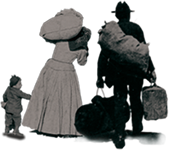The social life of the emigrants took place almost entirely within the Little Italies. Italian neighborhoods were always densely populated, and reproduced that energy and confusion typical of Italy, surrounded by street food vendors and hawkers. Community life was very much felt by Italian emigrants, who felt at home in their neighborhoods, and often also manifested forms of closure to the outside world, also due to language difficulties especially in English-speaking countries. This slowed down by quite a bit any form of integration, which in Latin American countries was faster, due to linguistic and cultural proximity.
The Little Italies often took on a regional connotation, which was fed by the migratory chain. The reference point was the neighborhood church, the heart of the patron saint's feast, and all those businesses where one could socialize with fellow countrymen, such as taverns, bars, and drugstores; here, frequently, it was possible to buy food products from the homeland.
In the Little Italies, associations among fellow countrymen were born: the first to spring up were those for mutual aid, which were essential to overcome any difficulties of members in a foreign country.

